Safety Analysis of Rebar Corrosion Depth at the Moment of Corrosion-Induced Cover Cracking
Abstract
:1. Introduction
2. Analytical Model for Rust and Swelling Cracking of the Concrete Protective Layer
2.1. Basic Model
2.2. Rust Depth of Reinforcement in the Free Expansion Phase of Rust
2.3. Depth of Corrosion of Reinforcement in the Cracking Stage of the Concrete Protective Layer
2.3.1. Basic Assumptions
- (1)
- Reinforced concrete is isotropic and concrete is an ideal elastic–plastic material, which satisfies the unified strength theory. The volume of reinforcing steel corrosion products expands at a uniform linear law, producing a uniformly distributed rust expansion force.
- (2)
- The geometry of the reinforced concrete to be analyzed as well as the constrained boundaries are symmetrical to the central axis of the reinforcement, and the stresses generated in the concrete are caused only by the corrosion of the reinforcement, which is simplified to a plane strain axisymmetric problem.
- (3)
- Under the action of a uniformly distributed rust expansion force, the cylindrical concrete around the reinforcement is composed of a plastic zone and an elastic zone from the inside to the outside. Among them, the plastic zone expands continuously with the increase in rust expansion force, and the rust expansion cracking model of the concrete protection layer is shown in Figure 4. In the figure: is the radius within the differential unit; is the radial positive stress; is the circumferential positive stress; is the radial pressure in the plastic zone of the circular hole; is the final internal pressure; is the small radial deformation in the plastic zone (caused by the radial stress action in the elastic zone); is the radius of the plastic zone during rust expansion; is the initial radius of the circular hole (due to the small gap at the intersection relative to , the approximation is taken as ); and is the final radius after expansion.
2.3.2. Theoretical Derivation
2.3.3. Depth of Corrosion of Reinforcing Steel When the Concrete Protective Layer Is Rusted and Expanded and Cracked
3. Influencing Factors
3.1. Concrete Void Ratio
3.2. Thickness of Concrete Protection Layer
3.3. Rust Volume Expansion Rate
3.4. Concrete Strength Level
3.5. Diameter of Reinforcing Steel
3.6. Yield Criterion Selection Parameter
4. Comparison of Theoretical Model Calculated Values and Experimental Values
5. Conclusions
Author Contributions
Funding
Institutional Review Board Statement
Informed Consent Statement
Data Availability Statement
Acknowledgments
Conflicts of Interest
References
- Tang, S.W.; Yao, Y.; Andrade, C.; Li, Z.J. Recent durability studies on concrete structure. Cem. Concr. Res. 2015, 78, 143–154. [Google Scholar] [CrossRef]
- Dwivedi, D.; Lepková, K.; Becker, T. Carbon steel corrosion: A review of key surface properties and characterization methods. RSC Adv. 2017, 7, 4580–4610. [Google Scholar] [CrossRef] [Green Version]
- Bonić, Z.; Ćurčić, G.T.; Trivunić, M.; Davidović, N.; Vatin, N. Some Methods of Protection of Concrete and Reinforcment of Reinforced-Concrete Foundations exposed to Environmental Impacts. Procedia Eng. 2015, 117, 419–430. [Google Scholar] [CrossRef] [Green Version]
- Zhang, L.; Niu, D.; Wen, B.; Luo, D. Concrete Protective Layer Cracking Caused by Non-Uniform Corrosion of Reinforcements. Materials 2019, 12, 4245. [Google Scholar] [CrossRef] [Green Version]
- Bazant, Z.P. Crack-band theory for fracture of concrete. Mater. Struct. 1983, 16, 155–177. [Google Scholar]
- Ye, H.; Jin, N.; Fu, C.; Jin, X. Rust distribution and corrosion-induced cracking patterns of corner-located rebar in concrete cover. Constr. Build. Mater. 2017, 156, 684–691. [Google Scholar] [CrossRef]
- Peterson, J.E. A Time to Cracking Model for Critically Contaminated Reinforced Concrete Structures; Virginia Polytechnic Institute and State University: Blacksburg, VA, USA, 1993; p. 25. [Google Scholar]
- Jin, W.-L.; Zhao, Y.-X.; Yan, F. The mechanism of corroded expansion force of reinforced concrete members. J. Hydraul. Eng. 2001, 31, 57–62. [Google Scholar]
- Jiang, H.; Yu, M.; Liu, R. Analysis on the internal cracking of concrete cover due to rebar uniform corrosion. Concrete 2014, 40, 70–75. [Google Scholar]
- Choe, G.; Shinohara, Y.; Kim, G.; Lee, S.; Lee, E.; Nam, J. Concrete corrosion cracking and transverse bar strain behavior in a reinforced concrete column under simulated marine conditions. Appl. Sci. 2020, 10, 1794. [Google Scholar] [CrossRef] [Green Version]
- Wang, P.-G.; Jiao, M.-P.; Fan, H.; Tian, L.; Wang, Y.; Yin, N.-N.; Zhang, X. Sesearch on the Rationality of Concrete Cover Values. China Concr. Cem. Prod. 2020, 4, 24–28. [Google Scholar]
- Zheng, J.-J.; Zhou, X.-Z.; Li, C.-Q. Analytical solution for corrosion damage of reinforced concrete structures. J. Hydraul. Eng. 2004, 12, 62–68. [Google Scholar]
- Tang, M.-X.; Chen, X.-B. Analysis of rebar rust cover cracking in reinforced concrete with cylindrical cavity expansion theory. J. Cent. South Univ. 2010, 41, 1172–1177. [Google Scholar]
- Andrade, C. Cover cracking as a function of bar corrosion. PartⅠ: Experimental test. Mater. Struct. 1993, 26, 453–464. [Google Scholar] [CrossRef]
- Zhang, J.; Ling, X.; Guan, Z. Finite element modeling of concrete cover crack propagation due to non-uniform corrosion of reinforcement. Constr. Build. Mater. 2017, 132, 487–499. [Google Scholar] [CrossRef]
- Dan, D.; Wang, Q. Computer Simulation of Corrosive Cracks on RC Members. J. Southwest Jiaotong Univ. 2000, 35, 484–487. [Google Scholar]
- Zhao, Y.-X.; Jin, W.L. Numerica-l based method for calculating reinforcement corrosion at concrete cover cracking due to corrosion. J. Zhejiang Univ. 2008, 42, 1080–1084. [Google Scholar]
- Chen, X.; Huo, S.; Wang, W.; Luo, Q. Finite Element Analysis for Corrosion and Cracking in Reinforced Concrete. J. Huaqiao Univ. 2022, 43, 36–43. [Google Scholar]
- Ronca, P.; Crespi, P.; Longarini, N.; Zucca, M.; Zichi, A. Structural analysis for an historical R.C. tall building restoration. In Proceedings of the Rehabend, Burgos, Spain, 24–27 May 2016; pp. 960–967. [Google Scholar]
- Verderame, G.M.; Stella, A.; Cosenza, E. Le proprietàeccanichee degli acciai impiegati nelle strutture in cemento armato realizzate negli anni ’60. In Proceedings of the X Convegno Nazionale “L’Ingegneria Simica in Italia”, Potenza and Matera, Italy, 9–13 September 2001. [Google Scholar]
- Berto, L.; Vitaliani, R.; Saetta, A.; Simioni, P. Seismic assessment of existing RC structures affected by degradation phenomena. Struct. Saf. 2009, 31, 284–297. [Google Scholar] [CrossRef]
- Crespi, P.; Zucca, M.; Valente, M.; Longarini, N. Influence of corrosion effects on the seismic capacity of existing RC bridges. Eng. Fail. Anal. 2022, 140, 106546. [Google Scholar] [CrossRef]
- Jin, W.; Zhao, Y.; Yan, F. Corroded expansion force of reinforced concrete members and its influence factors. Ind. Constr. 2001, 31, 6–8. [Google Scholar]
- Gong, L.; Liu, C. Durability of Concrete and Its Protection and Repair; China Construction Industry Press: Beijing, China, 1990. [Google Scholar]
- Gong, X. Soil Plasticity Mechanics; Zhejiang University Press: Hangzhou, China, 1997; pp. 251–261. [Google Scholar]
- Yu, M. A New System of Strength Theory: Theory, Development and Applications; Xi’an Jiaotong University Press: Xi’an, China, 2011; pp. 79–83. [Google Scholar]
- Song, Y.; Wang, Q. Reinforced Concrete Structure; Machinery Industry Press: Beijing, China, 2004; p. 54. [Google Scholar]
- Song, X. Corrosion of Reinforcing Steel in Reinforced Concrete Structures; Tsinghua University: Beijing, China, 1999. [Google Scholar]
- Zhang, W. Damage Prediction of Reinforcement Corrosion Rate of Concrete Structures and Its Durability Assessment; Tongji University: Shanghai, China, 1999. [Google Scholar]
- Jin, L.; Liu, M.; Zhang, R.; Du, X. Cracking of cover concrete due to non-uniform corrosion of corner rebar: A 3D meso-scale study. Constr. Build. Mater. 2020, 245, 118449. [Google Scholar] [CrossRef]
- Wang, X.; Deng, L.; Cao, H. Study on Rust Expansion of Concrete Protective ayer Based on Finite Element Simulation. Eng. Constr. 2018, 32, 445–446. [Google Scholar]
- Zhang, X.; Yao, L. Anti-seismic analysis of a particular super high-rise building in Nanjing. Shanxi Archit. 2021, 47, 45–47. [Google Scholar]
- Niu, D. Durability and Life Prediction of Concrete Structures; Science Press: Beijing, China, 2003. [Google Scholar]
- Alonso, C.; Andrade, C.; Rodriguez, J.; Diez, J.M. Factors controlling cracking of concrete affected by reinforcement corrosion. Mater. Struct. 1998, 131, 435–441. [Google Scholar] [CrossRef]
- Zhao, Y.; Jin, W. Analysis on the cracking of concrete cover due to rebar corrosion. J. Hydraul. Eng. 2005, 36, 939–945. [Google Scholar]
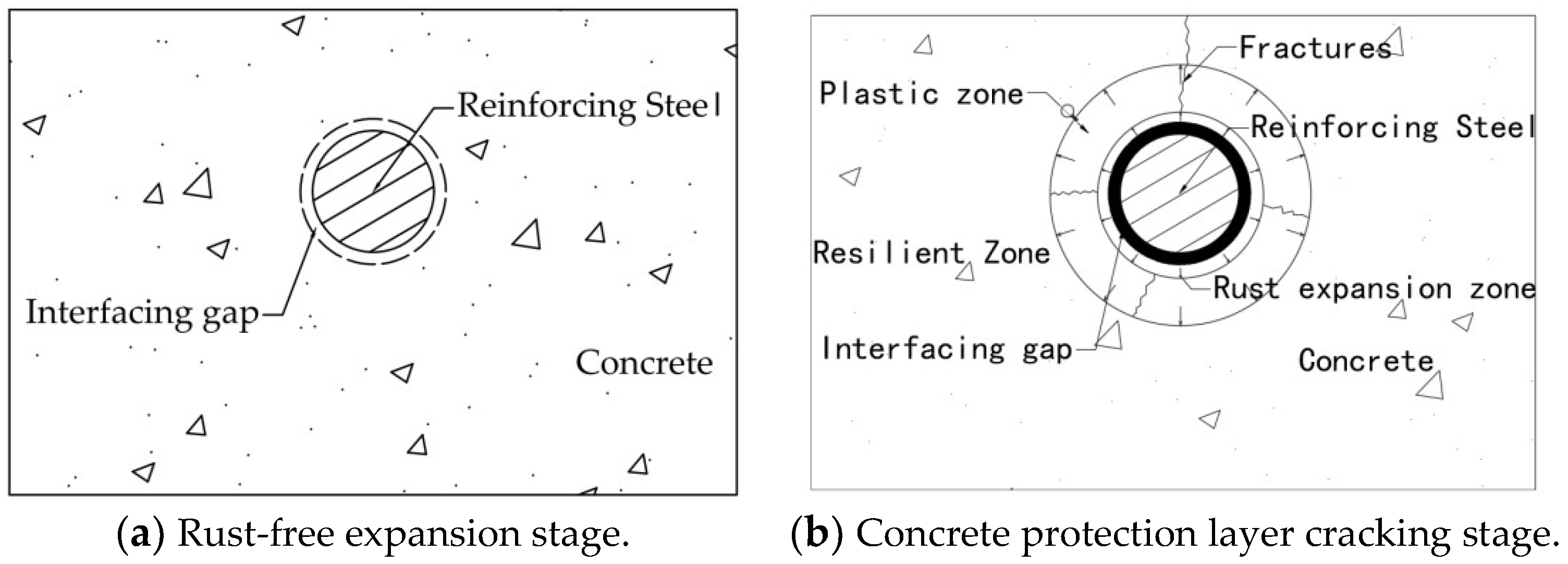
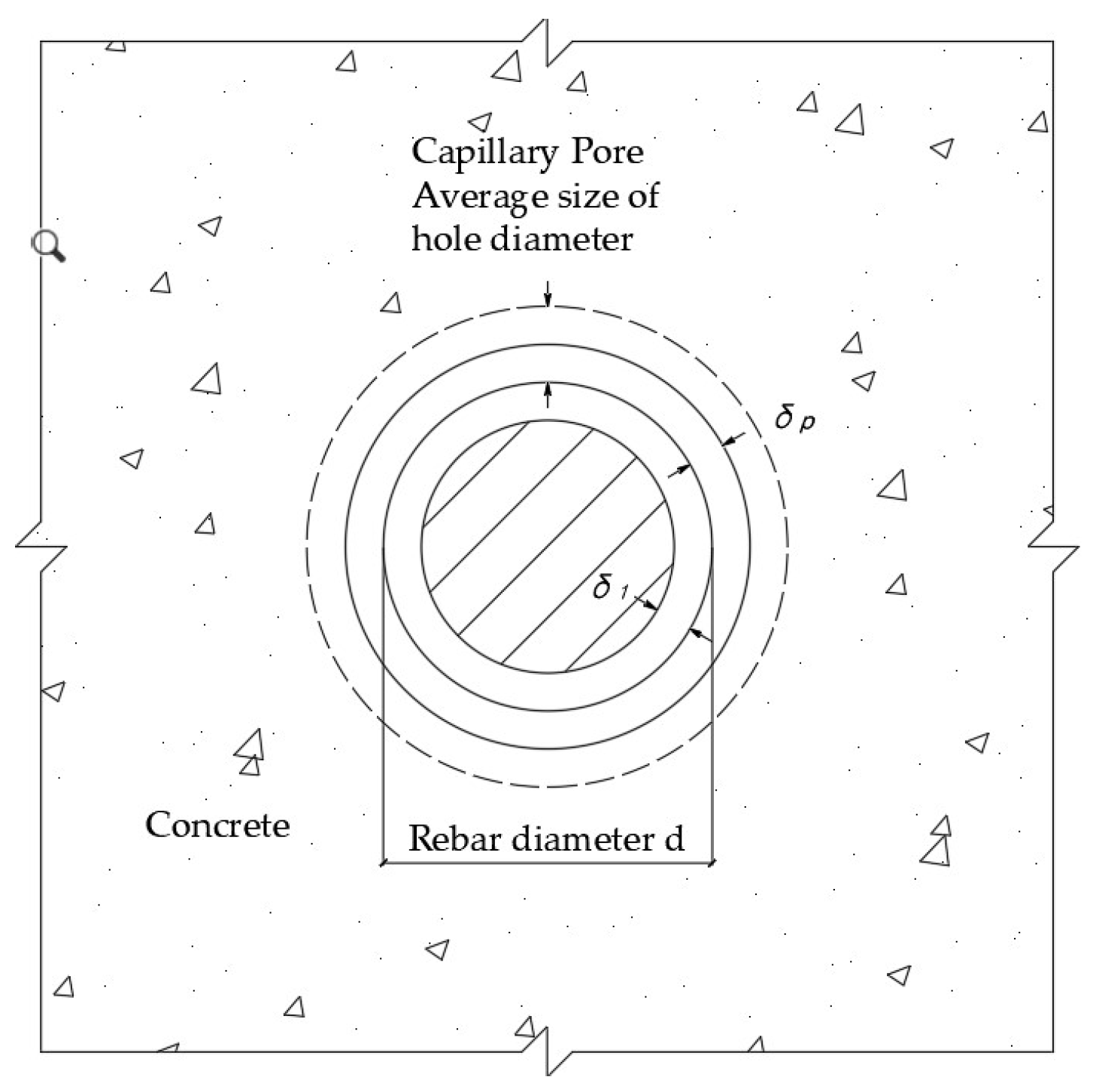

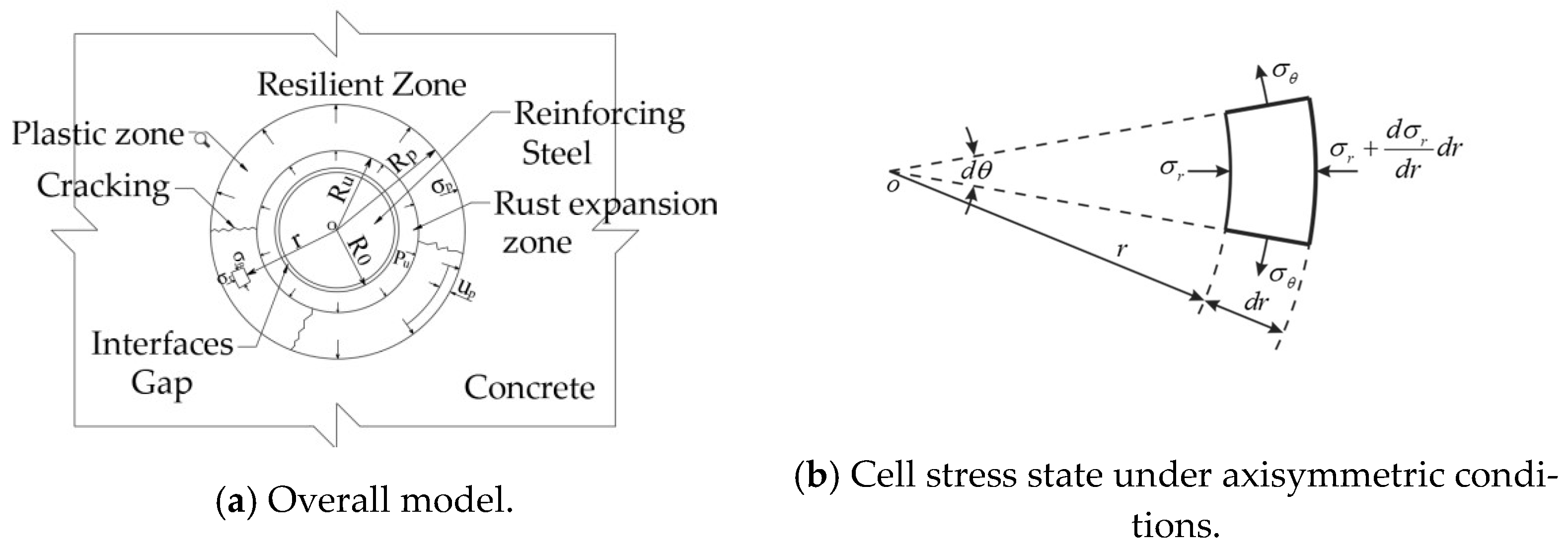
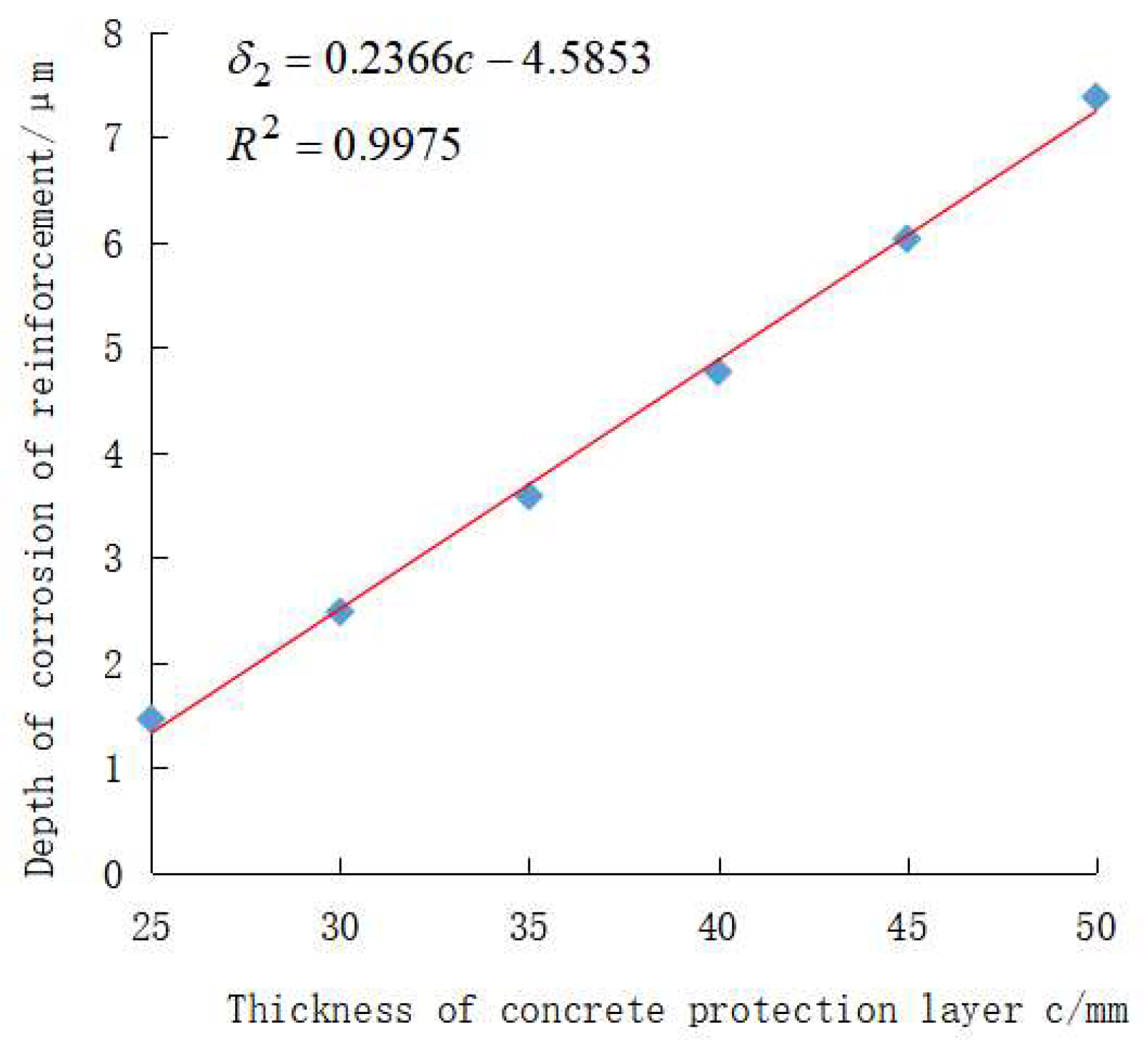

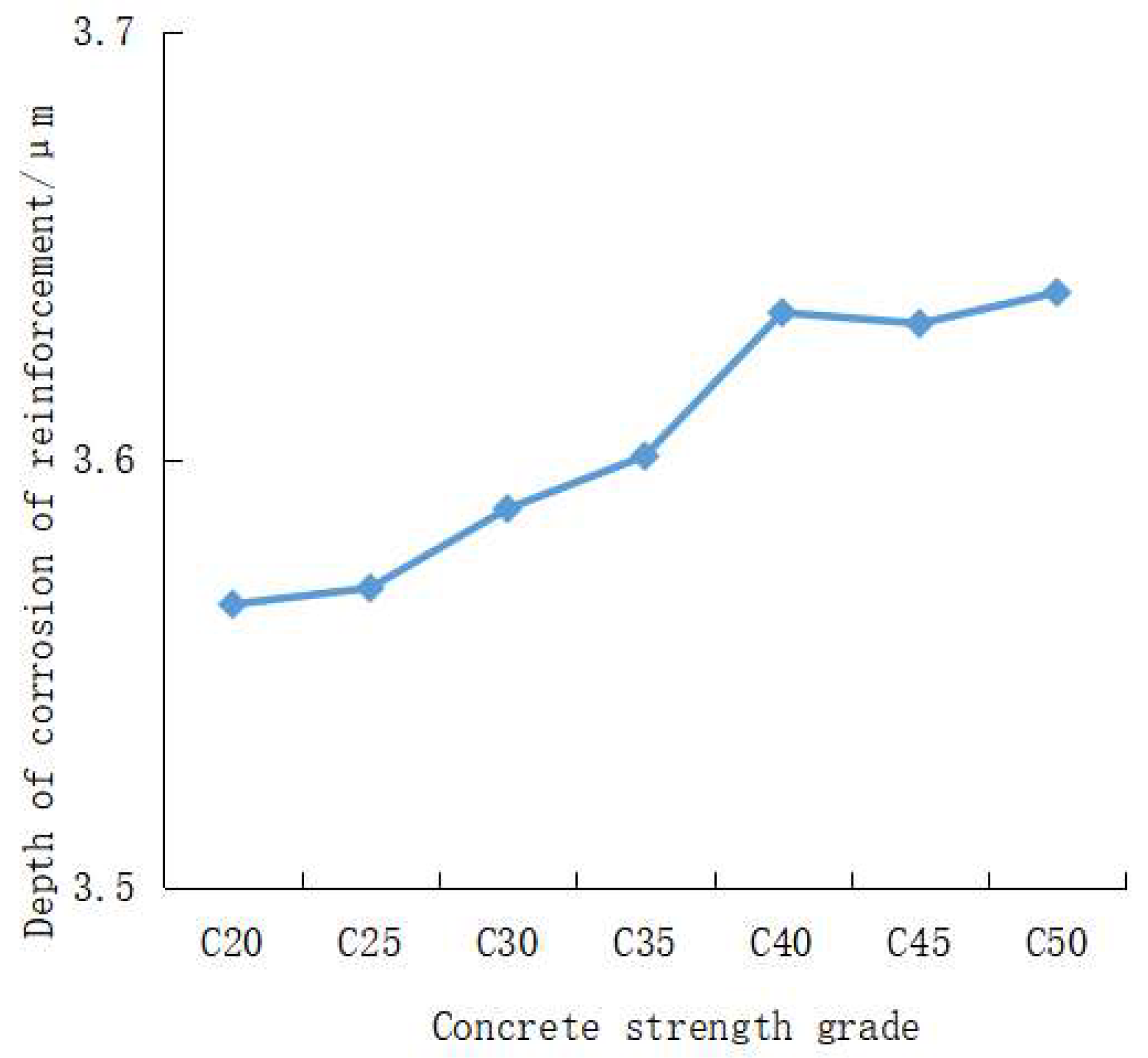

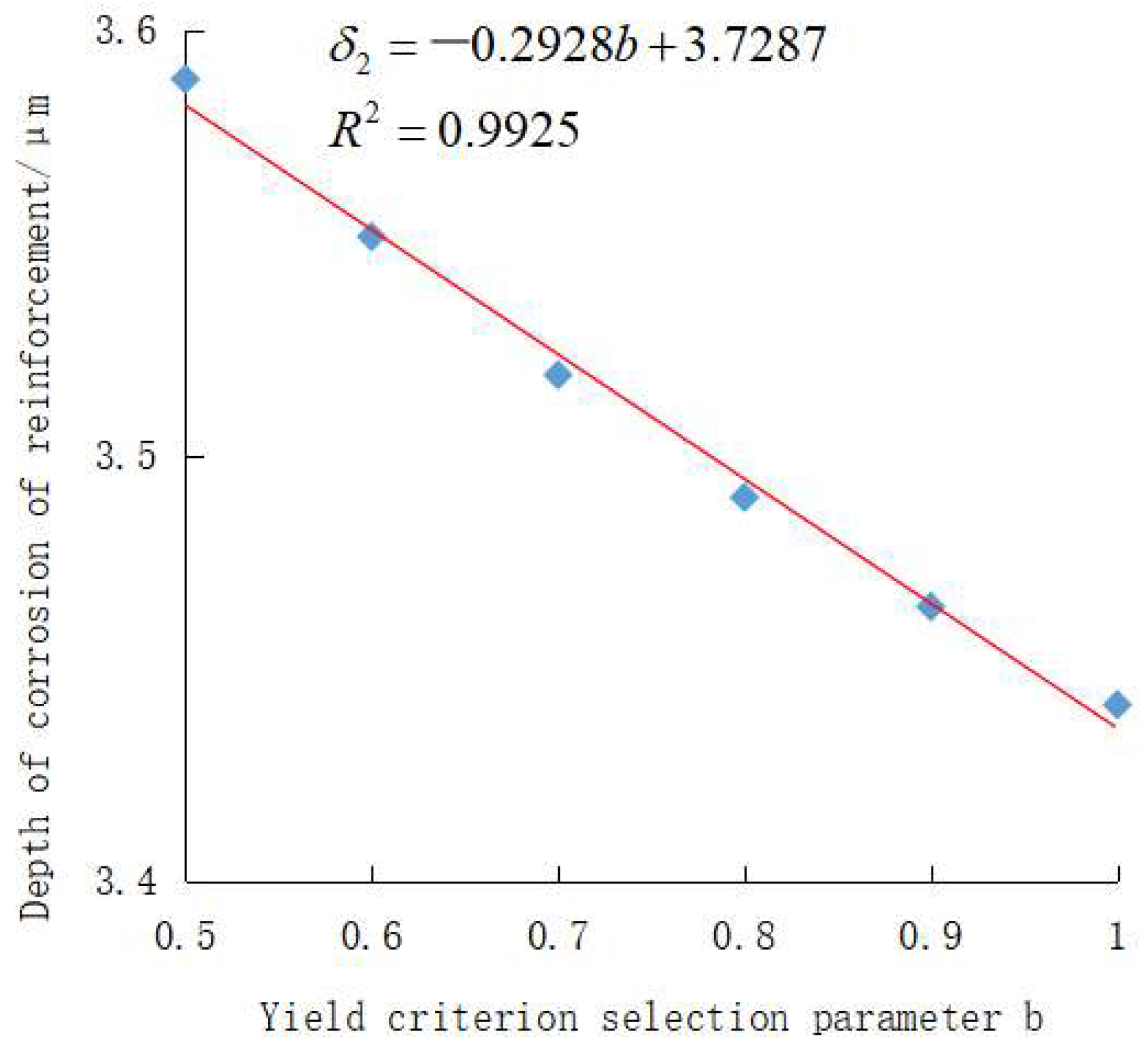
| Specimen No. | /mm | /mm | /Mpa | /Mpa | /Gpa | ||||||||
|---|---|---|---|---|---|---|---|---|---|---|---|---|---|
| Test Value | Theoretical Value | Error | Literature [35] | ||||||||||
| 1 | 10 | 44 | 4.4 | 0.5 | 2.2 | 31.1 | 31.5 | 3.10 | 9.85 | 11.94 | 12.95 | 1.01 | 10.70 |
| 2 | 16 | 42 | 2.63 | 0.5 | 2.2 | 31.1 | 31.5 | 2.50 | 6.27 | 9.31 | 8.77 | −0.54 | 7.60 |
| 3 | 10 | 20 | 2 | 0.5 | 2.2 | 31.1 | 31.5 | 0.98 | 2.31 | 4.27 | 3.29 | −0.98 | 3.10 |
| 4 | 16 | 17 | 1.06 | 0.5 | 2.2 | 31.1 | 31.5 | 1.54 | 0.56 | 3.20 | 2.10 | −1.10 | 3.10 |
| 5 | 20 | 40 | 2 | 0.4 | 2.7 | 42.1 | 35.5 | 1.78 | 4.69 | 6.36 | 6.47 | 0.11 | 6.60 |
| 6 | 20 | 40 | 2 | 0.5 | 2.2 | 31.1 | 31.5 | 1.08 | 4.61 | 6.36 | 5.69 | −0.67 | 5.38 |
| 7 | 20 | 40 | 2 | 0.5 | 2.2 | 31.1 | 31.5 | 2.10 | 4.61 | 7.47 | 6.71 | −0.76 | 6.40 |
| 8 | 20 | 40 | 2 | 0.5 | 2.2 | 31.1 | 31.5 | 0.89 | 4.61 | 6.89 | 5.50 | −1.39 | 5.19 |
| 9 | 20 | 40 | 2 | 0.6 | 1.8 | 23.3 | 28.0 | 4.94 | 4.56 | 8.53 | 9.50 | 0.97 | 8.80 |
Disclaimer/Publisher’s Note: The statements, opinions and data contained in all publications are solely those of the individual author(s) and contributor(s) and not of MDPI and/or the editor(s). MDPI and/or the editor(s) disclaim responsibility for any injury to people or property resulting from any ideas, methods, instructions or products referred to in the content. |
© 2023 by the authors. Licensee MDPI, Basel, Switzerland. This article is an open access article distributed under the terms and conditions of the Creative Commons Attribution (CC BY) license (https://creativecommons.org/licenses/by/4.0/).
Share and Cite
Jiang, H.; Wang, S.; Ren, Y.; Li, Y.; Song, S.; Qin, Y. Safety Analysis of Rebar Corrosion Depth at the Moment of Corrosion-Induced Cover Cracking. Sustainability 2023, 15, 2491. https://doi.org/10.3390/su15032491
Jiang H, Wang S, Ren Y, Li Y, Song S, Qin Y. Safety Analysis of Rebar Corrosion Depth at the Moment of Corrosion-Induced Cover Cracking. Sustainability. 2023; 15(3):2491. https://doi.org/10.3390/su15032491
Chicago/Turabian StyleJiang, Hui, Shengcheng Wang, Yaqun Ren, Yan Li, Shaolei Song, and Yanting Qin. 2023. "Safety Analysis of Rebar Corrosion Depth at the Moment of Corrosion-Induced Cover Cracking" Sustainability 15, no. 3: 2491. https://doi.org/10.3390/su15032491








